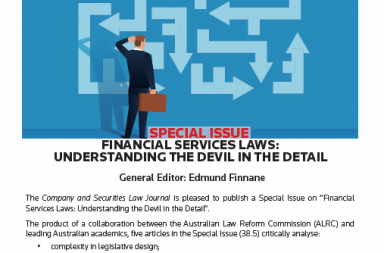*Please note that the links to the content in this Part will direct you to Westlaw AU.
To purchase an article, please email: [email protected] or contact us on 1300 304 195 (Australian customers) or +61 2 8587 7980 (international customers) during business hours (Mon-Fri, 8am-6pm AST).
The latest issue of the The Queensland Lawyer (Volume 38 Part 4) contains the following material:
EDITORIAL – General Editor: Andrew M West
- COVID-19 and the Courts
- Crowdfunding
- Motor Accident Claim Farming
- Protocol for the Bar to Raise Concerns about Judicial Conduct
- Going Digital in the High Court
- Child Protection Litigation
- Robing Update
- Hails, Farewells and Congratulations
ADMINISTRATIVE LAW – Editors: Bill Lane and Eleanor Dickens
- Natural Justice and the Bias Rule: CNY17 v Minister for Immigration and Border Protection [2019] HCA 50 – Bill Lane
COMMERCIAL LAW – Editor: Dr Clive Turner
- Effect of Payment of Life Insurance Premiums with Stolen Money: Hanson v Goomboorian Transport Pty Ltd [2019] QCA 41 – Clive Turner
CRIMINAL LAW – Editor: Andrew M West
- Witnesses called by the Court – A M West
INDUSTRIAL LAW – Editor: Dr Kristy Richardson
- Glass v Workers’ Compensation Regulator [2020] ICQ 001: The Connection between Injury and Employment – Kristy Richardson
Articles
Tidal Boundaries in Queensland: Theories, Principles, and Some Not So Ordinary Rules – Dr Chris Boge
It is taken for granted in Queensland that tidal lands are the property of the State. The State’s “ownership†has its origins in English common law. Today, it is codified by statute. The ownership’s English origins are somewhat obscure because they are said to be found in spurious theory and a claim by the Crown by prerogative right which found favour with sympathetic courts in the Stuart period of the seventeenth-century. In Queensland, the rules which commenced in 2010 under Div 2 of Pt 7 of the Survey and Mapping Infrastructure Act 2003 (Qld), for locating ambulatory tidal boundaries of land and, necessarily, for determining the landward extent of the State’s property in its tidal lands, including ambulatory boundary principles, are complex. An understanding of the statutory rules can, however, be enriched, and likely only comprehended, by an appreciation of some key common law theories, principles, and rules.
Does Property Held by a Bankrupt on Trust Vest in the Bankrupt’s Trustee in Bankruptcy? – Bill Dixon
Circumstances where a bankrupt holds property on trust may create a number of complexities for the bankrupt’s trustee in bankruptcy. In some instances, where a bankrupt trustee has a beneficial interest in the trust property (such as a claim to an indemnity for expenditure incurred by the trustee in the performance of the trust) the trust property vests in the bankrupt’s trustee in bankruptcy. However, if the bankrupt trustee does not have any beneficial interest in the trust property, the trust property will not vest in the bankrupt’s trustee in bankruptcy. This article examines a recent decision of the High Court which sheds light on some of the issues involved in the complicated interaction of a number of provisions of the Bankruptcy Act 1966 (Cth) and has implications for trustees in bankruptcy, their advisors and caveators more generally.
BOOK REVIEWS – Editor: Judge Brian Devereaux SC
- Authority to Decide: The Law of Jurisdiction in Australia (2nd ed), by Mark Leeming – Reviewed by Eleanor Sondergeld
- Interpreting Executive Power, by Janina Boughey and Lisa Burton Crawford (eds) – Reviewed by Matthew Hales
- Justice in Tribunals (5th ed), by JRS Forbes – Reviewed by Julius Moller
- Rectification of Documents, by John Tarrant – Reviewed by Kira Larwill
For the PDFÂ version of the table of contents, click here: Qld Lawyer Vol 38 No 4 Contents.
Click here to access this Part on Westlaw AU
For general queries, please contact: [email protected].


